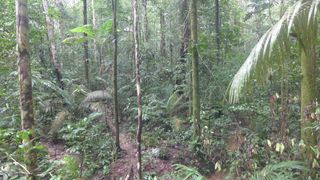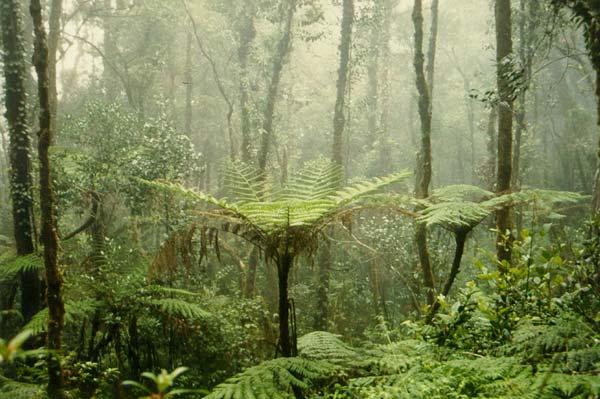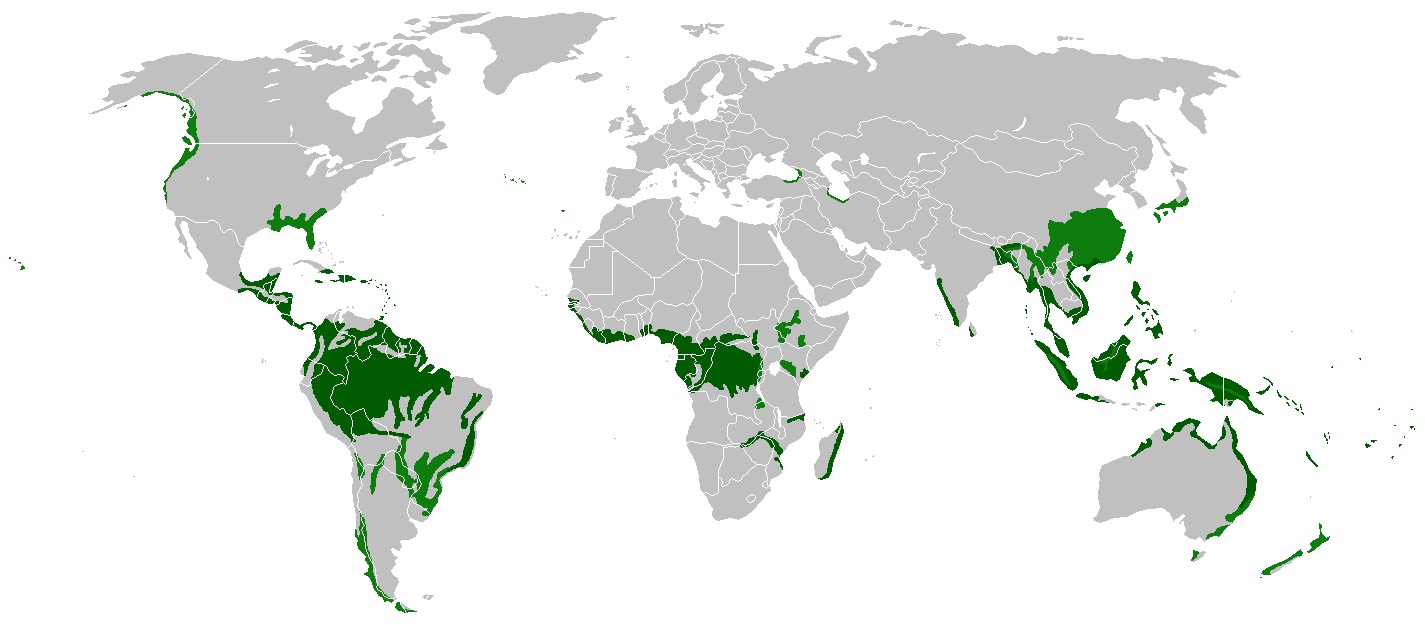How Many Species Of Animals Are In The Amazon Rainforest
Facts Virtually Rainforests

Rainforests are found all over the world — in Westward and Key Africa, Southward and Cardinal America, Indonesia, Southeast Asia and Australia — on every continent except Antarctica. They are vitally important, producing nearly of the oxygen we breathe and providing habitat for half of the planet'south flora and brute.
Types of rainforests
The term "rainforest" has a wide classification. Typically, rainforests are lush, boiling, hot stretches of state covered in tall, broadleaf evergreen trees, ordinarily found effectually the equator. These areas normally get rain year-round, typically more than than 70 inches (1,800 millimeters) a year, according to the Encyclopedia Britannica. Various types of forests, such equally monsoon forests, mangrove forests and temperate forests, can exist considered rainforests. Here's what makes them unlike:
- Temperate rainforests consist of coniferous or broadleaf trees and are found in the temperate zones. They are identified as rainforests past the large corporeality of rain they receive.
- Mangrove rainforests are, like their name, made of mangrove copse. These trees grow only in stagnant waters where rivers come across the sea.
- Monsoon rainforests are also called "dry out rainforests" because they have a dry out flavor. These get around 31 to 71 inches (800 mm to 1,800 mm) of rain. Up to 75 percent of the trees in dry rainforests can be deciduous.
Virtually rainforests are very warm, with an boilerplate temperature of 86 degrees Fahrenheit (30 degrees Celsius) during the day and 68 degrees F (xx degrees C) at dark.
A rainforest consists of two major areas. The very top part is called the canopy, which can be as tall as 98 anxiety to 164 feet (30 to 50 meters). This expanse is comprised of the tops of copse and vines. The rest, beneath the canopy, is called the understory. This tin include ferns, flowers, vines, tree trunks and dead leaves.
Some animals stay in the awning and rarely ever come down to the footing. Some of these animals include monkeys, flying squirrels and sharp-clawed woodpeckers, co-ordinate to the Encyclopedia Britannica. [Related: Explore the Amazon Rainforest with New Virtual-Reality Motion-picture show]

Animals and plants
The rainforest is home to many plants and animals. According to The Nature Conservancy, a iv-square-mile (2,560 acres) area of rainforest contains as many as 1,500 flowering plants, 750 species of copse, 400 species of birds and 150 species of butterflies. The Amazon rainforest lone contains around 10 pct of the world's known species.
Just well-nigh every blazon of brute lives in rainforests. In fact, though rainforests comprehend less than 2 per centum of Earth's total surface area, they are home to 50 percentage of Earth's plants and animals, according to The Nature Conservancy. For instance, rhinoceroses, deer, leopards, gorillas, chimpanzees, elephants, armadillos and even bears can be found living in rainforests across the world.
Many unusual animals and plants have been discovered in rainforests. For example, the fairy lantern parasite (Thismia neptunis) reappeared in the rainforest of Borneo, Malaysia, in 2018, 151 years afterwards information technology was get-go documented. This plant sucks on underground fungi and doesn't demand sunlight to survive. "To our cognition, it is simply the second finding of the species in total," the Czech team of researchers wrote in a paper, which was published Feb. 21, 2018, in the journal Phytotaxa.
Some of the animals are besides unusual. For example, the tapir is a mammal that looks like a mix between an anteater and a pig and can be constitute in the rainforests of Southward America and Asia. The stunning silverback gorilla lives in the rainforest of the Cardinal African Commonwealth. Wood giraffes, or okapi, a strange-looking cantankerous between a horse and a zebra, also inhabit the African rainforest.
One particularly surprising rainforest find is a spider as large as a puppy. The massive South American Goliath birdeater (Theraphosa blondi) is the earth's largest spider, co-ordinate to Guinness World Records. Each leg tin reach up to 1 pes (30 centimeters) long, and it tin weigh up to 6 ounces (170 grams). [Goliath Meet: Puppy-Sized Spider Surprises Scientist in Rainforest]
Lxx per centum of the plants identified past the U.Southward. National Cancer Plant as useful in the treatment of cancer are constitute only in rainforests, co-ordinate to The Nature Conservancy. Scientists have identified more than 2,000 tropical forest plants as having anti-cancer properties. Still, less than 1 pct of tropical rainforest species have been analyzed for their medicinal value.

Importance
Humans and animals rely on the rainforest to make the majority of World's oxygen. One tree produces nearly 260 lbs. of oxygen each year, according to the Growing Air Foundation, and 1 hectare (2.47 acres) of rainforest may contain over 750 types of trees.
A tree uses carbon dioxide to grow. A living tree draws in and stores twice as much carbon dioxide than a fallen tree releases. Just when the tree is cutting down, it releases its stored carbon dioxide. For example, dead Amazonian trees emit an estimated 1.9 billion tons (1.7 billion metric tons) of carbon dioxide into the atmosphere each year, co-ordinate to a report published in the periodical Nature Communications in 2014. The same trees typically blot about 2.ii billion tons (2 billion metric tons) of carbon dioxide. Carbon dioxide makes up around 82.2 percent of all U.South. greenhouse gas, according to the Environmental Protection Agency (EPA).
Out of the 6 1000000 square miles (15 million square kilometers) of tropical rainforest that once existed worldwide, simply two.4 1000000 square miles (six million square km) remain, and merely 50 percent, or 75 million square acres (30 meg hectares), of temperate rainforests still exists, according to The Nature Salvation. Ranching, mining, logging and agriculture are the main reasons for forest loss. Between 2000 and 2012, more than 720,000 square miles (ii 1000000 square km) of forests around the earth were cut down — an area about the size of all the states east of the Mississippi River.
Deforestation around the world also decreases the global catamenia of water vapor from land by 4 percent, co-ordinate to an article published by the periodical National University of Sciences. H2o constantly cycles through the atmosphere. It evaporates from the surface and rises, condensing into clouds. It is blown by the wind, and and so falls back to World as rain or snow. In addition, water vapor is the nearly important greenhouse gas in the atmosphere, co-ordinate to NASA. Even a slight change in the catamenia of water vapor can disrupt atmospheric condition patterns and climates.
"Rainforests are under increasing threats for many reasons, including logging, immigration for crops or cattle, and conversion to commercial palm oil plantations," Jonathan Losos, director of the Living Globe Collaborative and William H. Danforth Distinguished University Professor for the Department of Biological science, at Washington University in St. Louis, told Live Science. "On acme of that, the changing climate is having adverse effects on rainforest health. Last year was an especially bad 1 for the Amazon, with a substantial uptick in the rate of deforestation."
On the other paw, Losos said, in that location are some glimmers of hope:
- The two countries with the largest amount of rainforest – Indonesia and Brazil – take both acknowledged the importance of these forests and take taken innovative and aggressive efforts to halt deforestation.
- There is a growing understanding that halting deforestation and reducing carbon dioxide (CO2) emissions are closely linked; new, large-calibration efforts are under way to accost both concerns.
- While at that place is a continued reject in master rainforests, a bright spot is the fact that in many tropical countries, at that place is an extensive regeneration of secondary forests, which are disquisitional to supporting much of these countries' biodiversity.
Additional resource
- The Rainforest Foundation
- The Rainforest Alliance
- Scientific American: Measuring the Daily Destruction of the Earth'southward Rainforests
Source: https://www.livescience.com/63196-rainforest-facts.html
Posted by: richmondeliand.blogspot.com


0 Response to "How Many Species Of Animals Are In The Amazon Rainforest"
Post a Comment